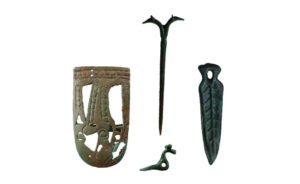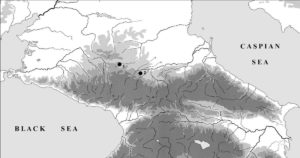
A group of scientists from the Institute of Archaeology RAS, NRC “Kurchatov Institute” and other scientific organizations for the first time have conducted a genetic analysis of the remains from cemeteries of the Koban culture, dated between the 9th and 5th centuries AD. The analysis of paleo- DNA of mitochondrial and Y-chromosome haplogroups has confirmed genetic succession of cultures of the ancient Caucasus and its relation both with ancient and with modern ethnic groups that inhabited this region. The results of the research were published in the Journal of Archaeological Science: Reports.
The skeletal remains of fourteen representatives of the Koban archaeological culture were selected for the research. Five were excavated from burials of barrow ‘Klin-Yar 3’ in the vicinity of modern Kislovodsk between 1994-1996, and nine others from a complex of archaeological sites near the village Zayukovo in Kabardino-Balkaria, which has been studied systematically since 2014 by the co-operative expedition of the State Historical Museum and Kabardino-Balkaria State University with participation of the IA RAS.
The samples of paleo DNA were extracted from teeth and bones in the laboratory of NRC “Kurchatov Institute” to identify maternal and paternal haplogroups, the groups that unite men who have common ascendants with similar mutation in the core or mitochondrial genome.
The analysis of the ancient DNA of the individuals from the burials of the Koban archaeological culture revealed the predominance of some mitochondrial and Y-chromosome haplogroups that spread in ancient Europe and Caucasus.
The main haplogroups of Y-chromosomes studied by the researchers are common for Caucasus and Europe in the period of the Iron Age: E1a2a, G2a1a, R1b and R1a.
The haplogroup G2a1a, which now is widely spread among the Ossetians, Balkars and Svans, is usually associated with Middle Eastern and European Neolithic cultures. Of special interest is the haplogroup discovered earlier during the examination of the buried in T-shape catacombs, which are traditionally related to the Alans inhabited Ciscaucasia and the Northern Caucasus in the period from the 1st to the beginning of the 2nd millennium.
The haplogroups R1a and R1b are usually associated with Indo-European migrations, described as the Scythes and Sarmatians. Today, these haplogroups together with the haplogroup E1a2a are identified as modern Northern Caucasian ethnic groups: the Balkars, the Karachi, the Darghins, the Lezghians and the Abkhazians. Therefore, the genetic researches have confirmed the theory about the Scythian influence on the Koban culture, which until the present has been based solely on archaeological material.
The haplogroups of the mitochondrial DNA of the humans who were buried in the cemeteries of Klin-Yar-3 and Zayukovo-3 are related to groups that were discovered earlier both as ancient and modern ethnic groups of the Northern Caucasus.
Among the burials, the male individual from the burial Zayukovo-3 stands out with a rare HV mitochondrial haplogroup that penetrated Europe through the territory of Caucasus after the last Ice Age Maximum (26.5 – 19 thousand years ago) and in the Neolithic period (10 – 3 thousand years ago). Moreover, this man was different with an unusual genetic origin and the paternal line, the haplogroup of the Y-chromosome of this sample D1a2a1, has been widely described in Eastern Asia.
_____________________________

The places of the burials of the Koban archaeological culture (1 – Klin-Yar 3; 2 – Zayukovo-3). Institute of Archaeology RAS
_____________________________

Bronze items from the barrow Zayukovo-3. Photo by A. Kadieva (SHM) and S. Demidenko (IA RAS)
_____________________________
Article Source: Institute of Archaeology RAS news release
_____________________________
Advertisement





